Transcription of The agriculture sectors in the Intended Nationally ...
1 PAPER. The agriculture sectors in the Intended Nationally determined contributions : Summary WORKING. THE agriculture . sectors IN THE. MANAGEMENT. Intended Nationally . determined . contributions : SUMMARY. RESOURCES. ] C L I M A T E C H A N G E. NATURAL. AND. [. ENVIRONMENT. E N V I R O N M E N T. Climate and Environment Division (NRC) Publications Food and agriculture Organization of the united Nations (FAO). I5666E/1 FAO. Background image in this page Illustration elaborated from L'Encyclop die Diderot et D'Alembert . The designations employed and the presentation of material in this information product do not imply the expression of any opinion whatsoever on the part of the Food and agriculture Organization of the united Nations (FAO) concerning the legal or development status of any country, territory, city or area or of its authorities, or concerning the delimitation of its frontiers or boundaries.
2 The mention of specific companies or products of manufacturers, whether or not these have been patented, does not imply that these have been endorsed or recommended by FAO in preference to others of a similar nature that are not mentioned. The views expressed in this information product are those of the author(s) and do not necessarily reflect the views or policies of FAO. FAO, 2016. FAO encourages the use, reproduction and dissemination of material in this information product. Except where otherwise indicated, material may be copied, downloaded and printed for private study, research and teaching purposes, or for use in non-commercial products or services, provided that appropriate acknowledgement of FAO as the source and copyright holder is given and that FAO's endorsement of users'.
3 Views, products or services is not implied in any way. All requests for translation and adaptation rights, and for resale and other commercial use rights should be made via or addressed to FAO information products are available on the FAO website ( ) and can be purchased through PAPER. WORKING. The agriculture sectors MANAGEMENT. in the Intended Nationally determined contributions : Summary RESOURCES. ] C L I M A T E C H A N G E. NATURAL. AND. [. ENVIRONMENT. E N V I R O N M E N T. Food and agriculture Organization of the united Nations Rome, 2016. Intended Nationally . determined . contributions (INDCs): NATIONAL PRIORITIES FOR. CLIMATE ACTION. The Intended Nationally determined contributions (INDCs) served as the basis for negotiations at COP21 and helped produce the Paris Agreement on climate change.
4 The INDCs will guide country-level climate action for the coming INDCs include not only targets, but also concrete strategies for addressing the causes of climate change and responding to its effects. As at 29 July 2016, 189 countries (190 Parties) had submitted a total of 161. INDCs and 22 NDCs to the united Nations Framework Convention on Climate Change (UNFCCC), 21 of which were originally submitted as This analysis considers the 22 NDCs and 140 remaining INDCs submitted as at 29 July 2016. In the remainder of this document, these are collectively referred to as the INDCs . The Food and agriculture Organization of the united Nations (FAO) has analyzed the INDCs and found that the agriculture sectors (crops, livestock, forestry, fisheries and aquaculture) feature prominently in meeting national mitigation contributions and adaptation objectives.
5 This is a clear signal: the agriculture sectors are central to the response to climate change. The INDCs were not prepared according to a standard format. While many Parties followed non-binding guidance, the INDCs are heterogeneous in length, coverage and level of detail. All 189 countries refer to mitigation contributions in their INDCs, while 71 percent include an adaptation section. Some specify detailed measures in specific sectors , while others only point to existing plans for further reference. This heterogeneity calls for caution in comparing country priorities and actions beyond broad patterns. This document is a summary of the FAO working paper, The agriculture sectors in the Intended Nationally determined contributions an Analysis'.
6 The working paper is available at 1 Following the Paris Agreement, the INDCs will be transformed into Nationally determined contributions (NDCs). 2 Latvia submitted the INDC on behalf of the European Union, which counts for 29 Parties (28 member states and the European Union). The following seven Parties had not provided (I)NDCs at the date of 29 July 2016: Libya, Nicaragua, The People's Republic of Korea, Palestine, the Syrian Arab Republic, Timor-Leste, Uzbekistan. 3. BOX 1. ]. C O N T R I B U T I O N S. METHODOLOGY AND COUNTRY CLASSIFICATION. Each INDC was read and analyzed in detail to ensure a comprehensive assessment of the coverage of the agriculture sectors . Original text was extracted into a database, which facilitates the replication and re-examination of the screening process.
7 The data was cross-checked using a keyword search. D E T E R M I N E D. Countries were aggregated according to their status of development (least-developed countries, developing countries, economies in transition and developed countries). As the focus of the analysis is on developing countries, these groups were further sub-divided by region. N A T I O N A L L Y. I N T E N D E D. T H E. I N. S E C T O R S. A G R I C U L T U R E. T H E. [. 4. Intended Nationally determined contributions (INDCs): NATIONAL PRIORITIES FOR CLIMATE ACTION. OVERVIEW: THE agriculture sectors IN THE INDCS. The agriculture sectors feature prominently in the INDCs. Many countries highlight the role of agriculture , forestry, fisheries and aquaculture in economic development, particularly for employment, exports and rural development.]
8 Many also point to the vulnerabilities of these sectors to climate change. The agriculture sectors are able to deliver considerable adaptation and mitigation benefits, and can often do so simultaneously. Many INDCs recognize these adaptation-mitigation synergies. In line with the structure of the UNFCCC. synthesis report,3 the mitigation results of this analysis are presented first. MITIGATION. Agriculture4 and land use, land use change and forestry (LULUCF) are among the most referenced sectors in countries' mitigation contributions (targets and/or actions). LULUCF is referenced in 83 percent of all countries'. INDCs, and as such is second only to the energy sector. agriculture is included in 78 percent of the countries' mitigation contributions .
9 When considered together 89 percent of countries refer to agriculture and/or LULUCF. Including the countries that only mention bioenergy as a mitigation strategy this percentage increases to 92 percent. The mitigation potential of agriculture and LULUCF is prominently acknowledged by developing countries in all regions and by all economic groupings. On average, 83 percent of developing countries in all regions point to agriculture and/or LULUCF as a means of mitigating climate change. Both sectors are well represented across all economic groupings: 98 percent of developed countries, 88 percent of economies in transition and 86 percent of developing countries (including least developed countries) point to agriculture and/or LULUCF when outlining their mitigation contributions in the INDCs.
10 Developing countries put a strong emphasis on agriculture and/ or LULUCF. As illustrated in Figure 1, 96 percent of countries in Sub-Saharan Africa refer to these sectors under their mitigation contributions . The corresponding figure in Eastern, South-Eastern and Southern Asia ranges between 89 to 100. percent. Among the Latin American and Caribbean countries, 91 percent refer to agriculture and/or LULUCF in their mitigation section. In Northern Africa and 3 See Synthesis report on the aggregate effect of the Intended Nationally determined contributions (2015), available at: 4 In the context of mitigation, the agriculture sector' in accordance with IPCC terminology includes emissions from enteric fermentation, manure management, rice cultivation, prescribed burning of savannas and grassland, and from soils ( agricultural emissions).
















